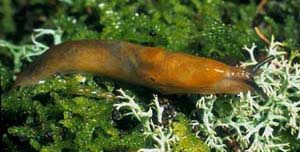Project coordinator: David Long
 Michael Kerney stated in the Atlas of the Land and Freshwater Molluscs of Britain and Ireland, 1999 that this species is restricted to ancient deciduous or coniferous woodlands, occasionally on chalk or limestone, but more commonly on poor acid soils. It is found mainly in ground litter, on logs and loose bark, emerging usually at night to feed, typically on fungi. It can live in a wide variety of woods including beech, oak, chestnut and pine, and tolerates traditional methods of management such as pollarding and coppicing. It is often found in places with Limax cinereoniger. Kerney (1999) shows the species is widely distributed in Britain but is absent from Ireland.
Michael Kerney stated in the Atlas of the Land and Freshwater Molluscs of Britain and Ireland, 1999 that this species is restricted to ancient deciduous or coniferous woodlands, occasionally on chalk or limestone, but more commonly on poor acid soils. It is found mainly in ground litter, on logs and loose bark, emerging usually at night to feed, typically on fungi. It can live in a wide variety of woods including beech, oak, chestnut and pine, and tolerates traditional methods of management such as pollarding and coppicing. It is often found in places with Limax cinereoniger. Kerney (1999) shows the species is widely distributed in Britain but is absent from Ireland.
Much of the British distributional and ecological information is based upon records extending back to the early 20th century. All of the records shown in the 1999 Atlas have been extracted from the Society's database, but these show that a significant number of the ‘recent’ records are over 25 years old. At many sites (e.g. the home counties and the New Forest), the species has not been recorded since the 1930s. Therefore, as a first objective this project will seek to reassess the current distribution of the species, with a particular focus on sites where it has not been recorded in the last 20 years, or at sites of known ‘ancient’ woodland where the species has not been recorded (e.g. the Welsh Borders. southeast England). As this is a species of conservation concern, there is a need for up-to-date information to assist the conservation agencies on best management practice.
There is much anecdotal information on the species’ autecology such as the best time of year to search, and its association with Russula species. The records suggest that this slug is best searched for from late summer to late spring, with the autumnal fungi season being the optimum period. Therefore, joining in fungus forays organised by mycological groups or local naturalist societies may well take you to potentially suitable Malacolimax tenellus sites (and this has the added advantage of obtaining an identification of the slug s food!)
Malacolimax tenellus is a relatively easy slug to recognise. It grows to a maximum of 4cm in length (when extended) and has a short keel along the back. The body colour is predominantly yellow (ranging from pale yellow to orange) and the sole is pale yellow. The head is grey/lilac and the tentacles are usually a distinctive bluey-grey or purple tinged. The body slime is yellow-coloured, not thick and sticky, and may he produced copiously if the slug is handled. As with all limacids, the pneumostome (breathing pore) is located posterior to the mantle mid-point, and on this basis, it may be distinguished from orange/yellow coloured arionids.
We advise against collecting and preserving specimens - the best way of verifying your identification is to take a photograph or a digital image for an expert opinion. Basic distributional information as provided by general mollusc surveys is clearly the first step in this project. However, we can gain a much greater understanding of the species' ecology from more detailed recording. Therefore we ask you to record details of the trees present, the overall ground habitat and associated flora, the fungi species present, and a precise habitat description for the specimen(s) you find. Details of any woodland management practices in operation will also be valuable.
We can provide members with details of historical sites in the areas they wish to survey, or suggest areas for a potential survey.
